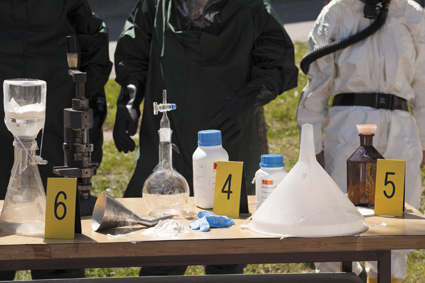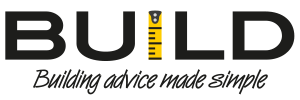
Electricians are on the frontline of the methamphetamine (or ‘P’) drug plague in Australia and New Zealand. As you enter homes and workplaces across the country, knowing what to expect and avoid, and how to respond, if you stumble upon a ‘clan lab’ is essential for your health and safety.
Individuals working in secret makeshift laboratories – clandestine laboratories, or ‘clan labs’ – in homes and rental properties cook the highly addictive drug methamphetamine, also known as ‘P’, using raw materials from certain imported cold and flu medicines, for sale to addicts.
The number of labs detected by NZ Police has risen rapidly from one in 1996 to around 135 labs found in 2010, which was declared recently as “an awful year” for methamphetamine dealers by Police Minister Judith Collins. A total of over 1,700 labs has now been located by the Police.
Still, it’s just the ‘tip of an iceberg’ according to drug education specialist Dale Kirk, managing director of Methcon. He says Customs is believed to be catching just 15%of illegally imported raw pharmaceutical material and there’s still plenty of P for sale on the streets. He suspects that large full-scale commercial laboratories are yet to be located in NZ.
“Tradespeople need to be aware of the very real health and safety dangers they face with these labs both from exposure to some very toxic chemicals and also from users,” he says.
In Australia the problem has also reared its ugly head. In June, two police officers in Western Australia were briefly hospitalised after suffering mild respiratory problems caused by chemical fumes that hit them as they opened the front door to bust a clandestine drug lab in Carlisle, West Perth.
In May, nine Brisbane police officers and six civilians including a baby were taken to hospital after fears they were exposed to a deadly gas at an illegal drug lab. And another month before that in April, three police officers were hospitalised, once again in Perth, after suffering burns to their noses, eyes and throats.
Clandestine drug labs are hazardous environments, and exposure to such can lead to any number of accompanying health effects; respiratory issues, skin irritation, nausea, dizziness, chemical burns – take your pick. At best, you could walk out feeling a bit crook. At worst, you could end up in hospital for a lengthy stint.
What to look for
From the outside, a home or workplace used as a clan lab looks like every other. On the inside they can be difficult to identify too – as sometimes they may consist of only a few bottles, dishes and hoses – but can range in size up to a full-scale commercial laboratory.
Tell-tale signs are chemical burning of vegetation outside the premises, discarded chemicals, and dark red/brown iodine stains on floors, walls, ceilings and pipes. Pipework may also be corroded. There may also be blacked out windows, unnecessarily secretive occupants – restricting access of landlords and contractors – an unusual smell like ammonia/cats’ urine or sweaty socks, extensive and expensive surveillance equipment like cameras, along with exhaust fans and quantities of pharmaceutical packaging, chemical containers and residues.
Companies like the NZ Drug Detection Agency, which offers quick tests for the presence of P, say that more than a third of people who suspect their homes have been used to cook or smoke P are proved correct.
Unfortunately, tradies won’t know whether they’ve been called to a ‘clan lab’ to fix a maintenance problem, therefore they should be vigilant no matter what property they enter. Make sure to check out the Australian Clandestine Drug Laboratory Remediation Guidelines.
Dangers of exposure
Just being in the clan lab environment is dangerous as you are exposed passively to the chemicals.
Recent research by the Institute of Environmental Science and Research (ESR) tested hair samples – which prove exposure to P for a much longer period than blood or urine samples – from children, aged from just two months old to 16, found in or near clan labs over a 2009-2010 period. 89% of the samples tested positive for exposure to P, in some cases for a period of six months or more. Their mean readings were exactly the same as for adults tested in 2009-2010.
The most danger for children is breathing in the fumes daily and the physical trauma and burns that could occur from the highly combustible products used in its manufacture, according to Dr Trecia Wouldes, a senior lecturer in psychological medicine from the University of Auckland. Referring to US research, she says the children might also accidentally eat the products used in P manufacture, as they are stored in the fridge next to food, or have contact with carpets or furniture that have absorbed the chemicals.
These dangers are also real for practitioners entering properties where the drug is being manufactured.
Anyone exposed to chemicals is advised to place the affected part under water and to seek medical help immediately.
Get out: call the police
P production is both unsafe and unhealthy.
Methcon advises that, if you find a clan lab, you leave the area immediately, as the manufacturing process creates a highly toxic and unstable situation. Never taste, touch or smell any chemicals or equipment and do not attempt to stop the chemical reaction.
It’s a highly explosive environment so do not turn off any lights or fans, smoke in or near the lab or use tools, mobile phones, torches or devices that produce sparks or friction.
Do not shut off the water supply to the house or to the chemical reaction.
Call the police or your local Council’s environmental health office.
Do not go back inside.
Speak and move slowly
Users of P will look fairly unwell and act erratically with unpredictable and changeable moods and delusions of grandeur and/or paranoia. Among other outward signs, they might have skin sores, spots and leathery grey/pale skin, sunken eyes, dilated pupils and rapid eye movements. Rotten discoloured teeth, lip biting, tongue-clicking and teeth-grinding, excessive sweating, extreme weight loss and lack of interest in activities they’ve been keen on in the past can be other signals.
The most dangerous point in the cycle of P use, according to Dale, is when the user has ‘binged’ on P and moves into the ‘tweaking’ stage. At that point, the user, then known as a ‘tweaker’, is extremely violent, unpredictable and paranoid.
“If you encounter this behaviour, speak slowly, move slowly, avoid bright lights, keep at a distance of two to three metres, keep them talking and contact the police.”
Clean up
Cleaning a house or flat involves airing out the building before and for three to five days after the clean up; removing and disposing of visibly contaminated items; and cleaning all surfaces and ventilation systems (replacing filters and clean vents and ducting). There are a number of commercial cleaners equipped to handle the hazards. The police also urge home owners to get a professional plumber to clean the plumbing.
The New Zealand Ministry of Health issued some guidelines in the middle of last year dealing with cleaning up clan labs. These aim to help public health staff of district health boards and other agencies, such as territorial authorities, in addressing public concerns and giving practical advice about the sometimes small amounts of contamination that can be left on surfaces and in absorbent materials, like carpets and furniture, and also in sinks, drains and ventilation systems.
Be aware. Be informed
Being armed with information seems the key to keeping yourselves and your staff out of harm’s way. The release of the National Guidelines was a huge step forward for the issue of clan labs and protecting the wider community from these hazardous and contaminated sites.
All tradesmen and women should make themselves aware of the dangers and learn how to protect themselves in the rare case that they may be called to a clan lab. The Clandestine Drug Laboratory Remediation Guidelines are available at www.ag.gov.au.
Anyone with information in relation to suspected clan labs, methamphetamine and other controlled drugs can contact their local police station or ring Crimestoppers on 1800 333 000 (0800 333 000 for NZ).
This is not a problem specific only to New Zealand. In Australia drug laboratories also pose an increasing health risk to the public.





